Root cellars work best for apples because they naturally maintain the perfect storage conditions. You'll find they keep temperatures between 32-40°F and humidity levels at 85-95%, which is exactly what apples need for long-term storage. The earth's natural insulation prevents temperature swings, while the underground environment creates consistent moisture levels that stop your apples from shriveling. You won't need electricity since the cellar's design uses the ground's cooling properties and natural ventilation to regulate ethylene gas buildup. Understanding these natural preservation methods can help you store your harvest through winter and beyond.
Natural Temperature Control Systems
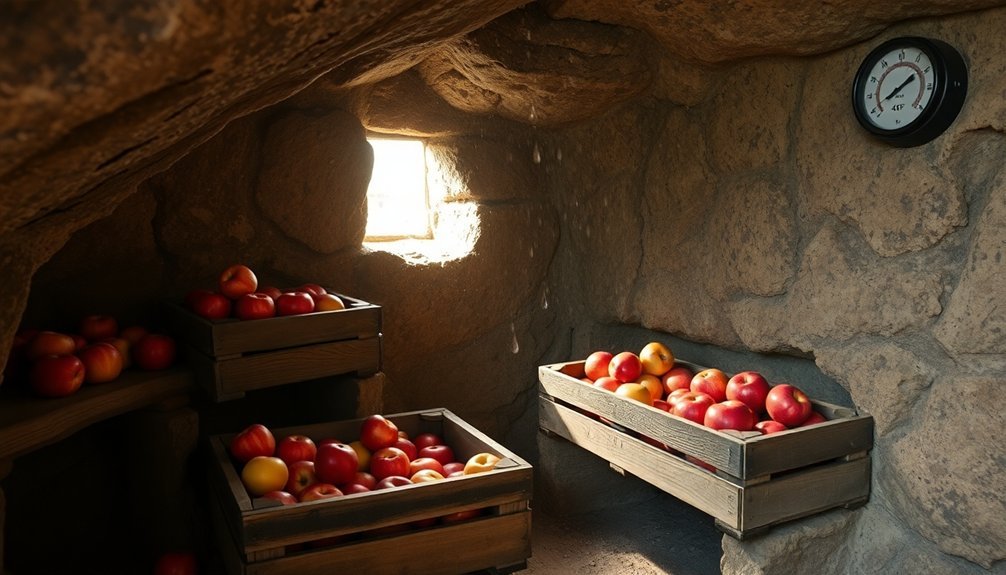
Nature's ingenuity provides the perfect blueprint for maintaining ideal storage conditions in a root cellar. When you're storing apples, you'll want to maintain temperatures between 30-32°F, which falls perfectly within a root cellar's natural cooling capacity.
Regular temperature and humidity monitoring helps ensure optimal storage conditions throughout the seasons. By choosing a north-facing slope or shaded location, you'll harness the earth's natural ability to maintain consistent cool temperatures.
You'll find that building into a hillside offers exceptional temperature control, as the surrounding earth acts as natural insulation. This approach helps you keep steady temperatures while minimizing fluctuations that could speed up apple deterioration.
When you construct your cellar below the frost line, you're protected from freezing temperatures that could damage your stored fruit.
To optimize your cellar's natural cooling system, you'll need proper ventilation. Installing intake vents low on one side and exhaust vents high on the opposite side creates natural air circulation.
This setup helps control ethylene gas release from the apples and maintains even temperatures throughout the space. You can enhance this natural system with solar-powered or traditional fans to guarantee consistent airflow and prevent temperature stratification.
Earth's Built-in Humidity Benefits
You'll find that earth's natural moisture creates an ideal environment for apple storage, as the ground itself acts as a natural humidifier to maintain consistent moisture levels.
Temperature control remains steady underground, keeping apples at their optimal storage range of 32-40°F.
The underground setting naturally prevents excess evaporation, which helps your apples retain their crisp texture and fresh flavor longer than above-ground storage methods.
Your root cellar's soil-surrounded walls work continuously to regulate humidity, eliminating the need for artificial humidification systems while providing the 85-95% humidity level that apples need for excellent preservation.
Natural Moisture Retention Process
Root cellars tap into the earth's natural ability to maintain high humidity levels, creating an ideal environment for apple storage. You'll want to maintain humidity between 85-95% to prevent your apples from shriveling and losing their natural moisture content. The optimal storage temperature range of 30-32°F helps preserve freshness while working alongside humidity control. By utilizing materials like damp sand or moistened burlap sacks, you can help maintain these best conditions.
The high humidity environment works by reducing moisture loss through evaporation, while proper ventilation guarantees the humidity distributes evenly throughout your cellar. You'll need to organize your produce carefully to allow adequate air circulation, which prevents moisture from becoming trapped and causing mold growth.
To manage humidity effectively, you'll want to monitor levels regularly using a hygrometer. When the cellar feels too dry, you can introduce moisture through damp materials. Conversely, if humidity climbs too high, adjust your ventilation to bring it back to best levels.
It's vital to maintain consistent conditions that mimic the apple's natural environment, as this slows down decay and prevents spoilage. Regular checks for signs of decay will help you adjust conditions as needed to keep your apples fresh longer.
Underground Climate Control Benefits
Deep beneath the surface, underground root cellars harness the earth's remarkable climate control capabilities to create perfect storage conditions for apples.
You'll find that the earth's natural insulation maintains temperatures between 32-40°F, precisely the range needed for prime apple storage. This consistent temperature shield protects your apples from both winter freezing and summer heat, greatly reducing the need for artificial climate control.
The earth's natural moisture regulation system maintains humidity levels between 85-95%, which you'll need to prevent your apples from drying out. This high humidity slows down the respiration process while preventing mold growth and decay.
You're also benefiting from the earth's ability to facilitate proper air circulation, which prevents the harmful buildup of ethylene gas and maintains ideal oxygen and carbon dioxide levels.
You'll appreciate how these underground conditions perfectly mimic autumn days, creating an ideal environment that reduces stress on your stored apples.
The stable environment you'll find in a root cellar helps preserve your apples' nutritional content, texture, and flavor profiles while providing consistent protection from extreme weather fluctuations throughout the seasons.
Evaporation Prevention Properties
Building on the earth's natural climate control abilities, its evaporation prevention properties offer remarkable protection against moisture loss. You'll find that root cellars naturally maintain humidity levels between 85-95%, which is perfect for storing apples and other fruits. The earth's inherent moisture helps create this ideal environment, preventing your produce from drying out and losing flavor.
To maximize these natural humidity benefits, you can enhance the environment with simple additions:
- Place damp sand or straw around storage areas
- Mist burlap sacks with water periodically
- Pour water on the floor to allow natural evaporation
You'll need to balance humidity with proper ventilation to prevent mold growth and remove ethylene gas, which can speed up ripening. If you notice your apples starting to shrivel, it's a sign that humidity levels have dropped too low. You can correct this by introducing moisture through any of the methods mentioned above.
While the earth provides excellent baseline humidity control, monitoring and adjusting conditions will guarantee your apples stay crisp and flavorful throughout their storage period. A well-maintained root cellar's humidity system works in harmony with its ventilation to create ideal storage conditions.
Underground Protection From Light
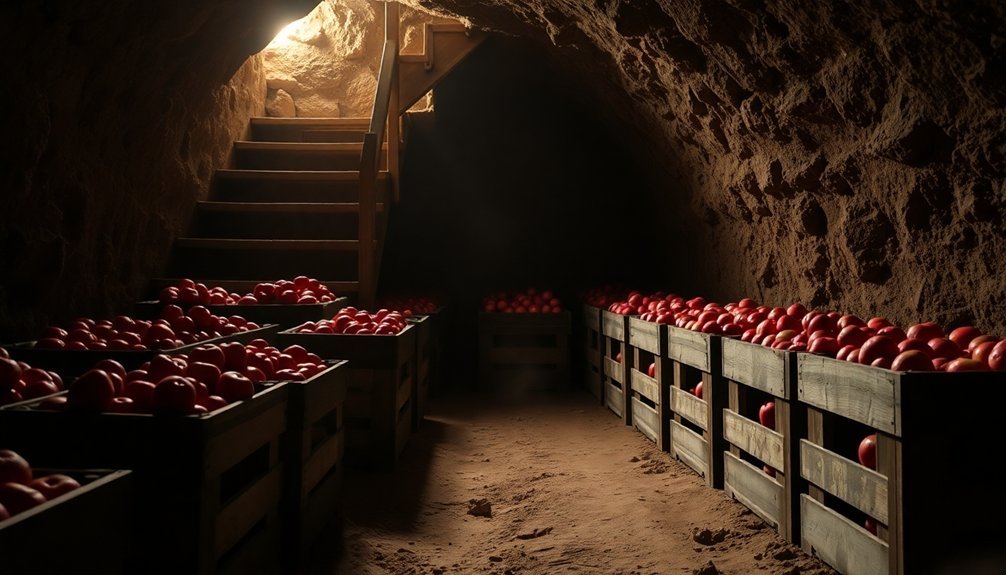
Your root cellar's underground location provides excellent natural light barriers, keeping your apples in complete darkness throughout their storage period.
The earth's thickness acts as a shield, blocking out harmful light rays that could trigger premature ripening and affect the quality of your stored apples.
This deep shade protection is essential for maintaining the ideal dark environment that helps preserve your apples' freshness and extends their storage life.
Natural Light Barriers
Underground storage naturally creates an effective barrier against unwanted light, making root cellars ideal for apple preservation. The earth's natural insulation provides protection from external light sources, while the minimal light that enters through small gaps, like those between door planks, isn't enough to affect your stored produce.
You'll find that this natural darkness helps maintain excellent storage conditions for your apples, slowing down the ripening process and preventing spoilage.
To maximize the effectiveness of these natural light barriers, you'll want to focus on:
- Installing tightly fitting doors and screens to block any external light infiltration
- Using the cellar's artificial lighting only when necessary, turning it off immediately after use
- Adding insulation and earth covering on the roof to further reduce light penetration
When you're storing apples in your root cellar, you can enhance the natural darkness by wrapping them in newspaper for extra protection.
This combination of natural barriers and proper storage techniques creates an environment where high humidity and cool temperatures work together with darkness to extend your apples' shelf life considerably.
Deep Shade Protection
Deep within the earth's protective embrace, root cellars offer superior shade protection that's essential for long-term apple storage. You'll find that the natural insulation maintains temperatures between 32-40°F, creating an ideal environment for your apples while preventing light exposure that could trigger premature ripening.
| Benefit | How It Works | Impact on Apples |
|---|---|---|
| Temperature Control | Earth's insulation | Maintains 32-40°F range |
| Light Protection | Underground location | Prevents sprouting |
| Humidity Management | Natural moisture | Preserves fruit quality |
| Ethylene Control | Reduced metabolism | Slows ripening process |
You'll appreciate how this deep shade protection works in multiple ways to preserve your harvest. The darkness reduces ethylene production, which means your apples won't ripen as quickly. Since root cellars utilize the earth's natural cooling properties, you won't need expensive electrical systems to maintain proper storage conditions. The result? Your apples can stay fresh for several months, reducing food waste and ensuring you have access to quality fruit throughout the year. This natural approach not only protects your produce but also offers an energy-efficient solution for long-term storage.
Ethylene Gas Management Features
Managing ethylene gas levels stands as one of the most critical aspects of apple storage in root cellars. Since apples are high ethylene producers, you'll need to implement specific features to control this ripening hormone and prevent premature spoilage of your stored produce.
Your root cellar should incorporate these essential ethylene management features:
- Separate storage zones to keep ethylene-producing apples away from sensitive produce like carrots and onions
- Strategic ventilation systems or fans to maintain consistent airflow and prevent ethylene buildup
- Ethylene removal methods such as scrubbers or catalytic converters to maintain concentrations below 1 ml l-1
You can enhance your cellar's effectiveness by combining multiple control strategies. Installing proper ventilation helps distribute humidity while removing excess ethylene gas.
If you're storing large quantities of apples, consider using specialized ethylene scrubbing systems paired with low oxygen storage (5% CO2 + 1% O2).
Don't forget to monitor air circulation regularly and adjust your ventilation as needed. For additional humidity control, hang moistened burlap sacks throughout your storage area, which will help maintain ideal conditions while supporting proper air movement.
Traditional Root Cellar Design
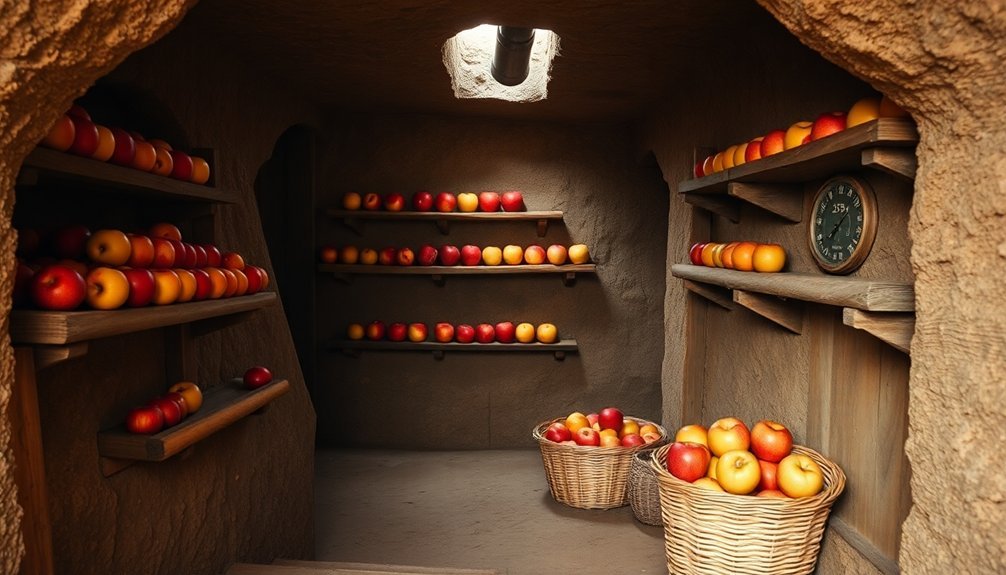
You'll find traditional root cellars work best when built underground or into hillsides, where the earth's natural insulation maintains consistent temperatures between 32-40°F for your apples.
The underground placement also creates ideal humidity levels of 85-95%, as moisture naturally releases from the surrounding earth to keep your apples from shriveling.
Building into a north-facing slope provides the most stable environment, as it shields your cellar from temperature fluctuations caused by direct sunlight.
Underground Temperature Control
Because traditional root cellars harness the earth's natural insulation properties, they provide remarkably stable temperatures for storing apples and other produce. When you build your root cellar into the ground or a hillside, you'll benefit from the earth's consistent temperature profile, which maintains ideal conditions between 32-40°F (0-4°C).
You'll find that depth plays a significant role in temperature control. The deeper you go, the more stable and cool the temperature becomes, especially in hot climates. At depths around 30 meters, groundwater temperature can help maintain a steady 10°C, though most root cellars don't need to go that deep to be effective.
To maximize temperature control in your root cellar, you'll want to focus on these key elements:
- Proper ventilation systems to regulate temperature and humidity levels
- Strategic use of insulating materials like sand, old tires, or cinder blocks
- Double-door entrances or small porches to create temperature barriers
You can fine-tune your cellar's temperature by adjusting ventilation schedules and using monitoring devices like thermometers to track conditions.
Different areas within your cellar may have slight temperature variations, so you'll need to position your apples strategically.
Natural Humidity Solutions
Natural humidity control stands at the heart of successful root cellar design, particularly for apple storage. Your root cellar needs to maintain humidity levels between 85-95% to prevent your apples from shriveling and losing their fresh, crisp texture.
Earth-based construction naturally helps you achieve these favorable conditions through its inherent moisture-regulating properties. You'll find that using traditional materials like stone, wood, and sod in your cellar's construction helps maintain consistent humidity levels.
By digging into a hillside, you're taking advantage of the earth's natural ability to regulate moisture while guaranteeing proper drainage. Adding straw or sand to your cellar floor can boost humidity levels when needed.
To prevent mold growth and ethylene gas buildup, you'll need to guarantee proper airflow throughout your storage space. You can hang moistened burlap sacks and install ventilation systems to maintain ideal conditions.
Don't forget to monitor humidity levels regularly with a hygrometer and adjust your ventilation accordingly. Remember to remove any spoiled apples promptly, as they can affect the overall storage environment and compromise your healthy produce.
Best Apple Storage Practices
Successful apple storage hinges on maintaining precise temperature and humidity levels while using proper storage techniques. You'll want to keep temperatures between 30-35°F (0-2°C) and maintain relative humidity between 80-95%. Be careful not to let temperatures drop below 29.4°F, as this will cause freezing and quality deterioration.
Select apple varieties known for their storage longevity. Thick-skinned varieties like Braeburn, Rome, and Northern Spy excel in long-term storage, while Honeycrisp and Red Delicious can last up to six months when stored correctly.
- Use perforated plastic bags or breathable mesh containers to guarantee proper air circulation.
- Store apples separately from other produce to prevent accelerated ripening from ethylene gas.
- Check regularly for signs of spoilage and remove any affected fruit immediately.
To maintain ideal conditions, you'll need to monitor your storage area consistently. Keep the space dark and away from heat sources, and consider using a humidifier to maintain proper moisture levels.
Don't forget to inspect the apples periodically for soft spots or mold, and keep stems intact to preserve freshness. If you're planning for very long-term storage, consider alternative preservation methods like canning or dehydrating.
Root Cellar Location Considerations
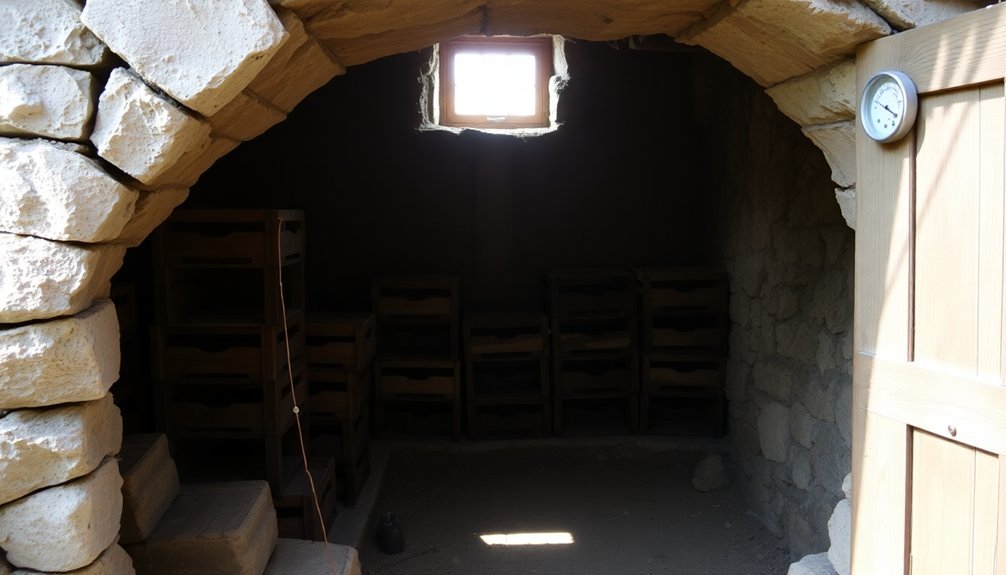
Selecting the right location for your root cellar requires careful consideration of four key factors: ground temperature, drainage, accessibility, and natural ventilation. When you're choosing a spot, you'll want to take advantage of the earth's natural cooling properties to maintain the ideal 32-40°F temperature range that apples need.
You'll need to position your root cellar where water won't collect, as excess moisture can compromise your storage conditions and make it difficult to maintain the best 90-95% relative humidity.
Consider placing vents at different heights to create natural airflow, and make sure they're covered with mesh to keep pests out. You can enhance air circulation by installing a temperature-controlled fan system that draws in cool night air.
If you're building into a hillside, position the entrance facing north to minimize sun exposure. This helps maintain darkness inside the cellar, which is essential for preventing premature ripening.
Don't forget to include an ante-chamber in your design – it'll act as a buffer zone, helping you maintain consistent temperature and humidity levels when you enter and exit the storage area.
Seasonal Storage Timeline
A well-planned storage timeline can mean the difference between crisp, flavorful apples and a disappointing harvest.
You'll want to start by picking your apples at their peak of freshness, when they've developed their full color and flavor. It's essential to get them into cold storage within 24 hours of harvesting, but be sure to pick them before the first hard frost hits.
Your storage timeline will vary depending on the apple varieties you've chosen. While most apples can keep for 3-6 months under proper conditions, some varieties like Honeycrisp can last over 8 months.
You'll need to monitor your apples regularly and remove any that show signs of spoilage.
Here's what you can expect during different storage periods:
- Short-term (0-3 months): Apples maintain their fresh-picked quality with minimal deterioration
- Medium-term (3-6 months): Most varieties remain viable, and some may even improve in flavor
- Long-term (6+ months): Only specific varieties like Stayman-Winesap and Honeycrisp will maintain quality this long
Preservation Through Natural Methods
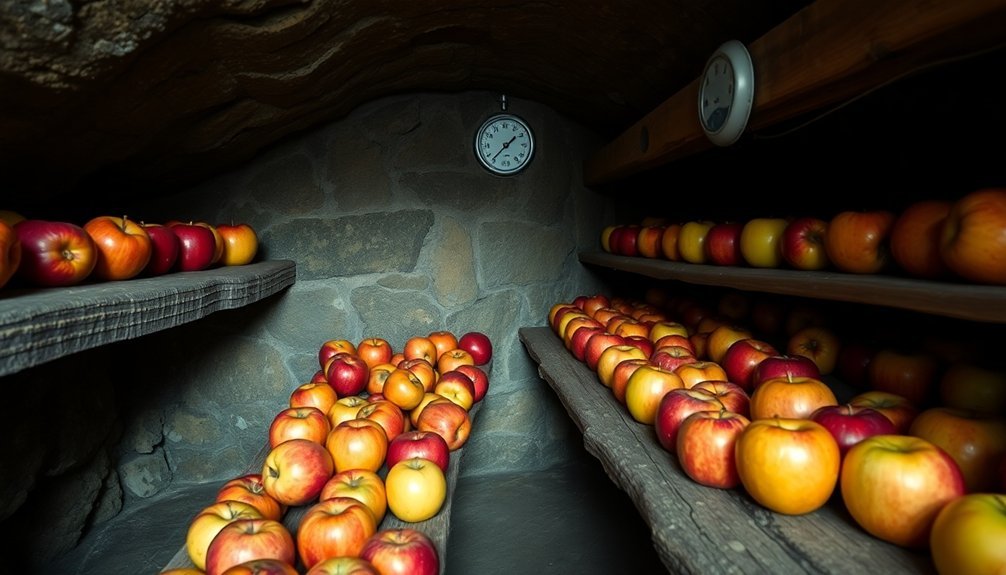
With your storage timeline mapped out, preserving apples through natural methods becomes your next priority. You'll need to maintain specific environmental conditions in your root cellar to maximize preservation. The key lies in controlling temperature, humidity, and ventilation to slow down the natural ripening process.
Keep your root cellar's temperature between 30-40°F and humidity at 90-95%. You'll want to guarantee proper ventilation to prevent ethylene gas buildup, which can accelerate ripening. Dark conditions are essential, as light exposure can affect the ripening process.
| Natural Factor | Impact | Control Method |
|---|---|---|
| Temperature | Slows metabolism | Insulation & depth |
| Humidity | Prevents dehydration | Dirt floor & walls |
| Ventilation | Removes ethylene | Air vents & pipes |
Select thick-skinned, late-ripening varieties like Jonathans or Northern Spy for best results. You'll find these varieties store longer than early-ripening ones. Check your stored apples regularly for signs of spoilage, and remove any that show deterioration. Remember that proper root cellar design, including hillside placement and adequate structural support, creates the ideal natural preservation environment.
Modern Root Cellar Adaptations
Modern adaptations have transformed traditional root cellars into versatile storage solutions that blend time-tested methods with contemporary innovations.
You'll find that today's root cellars incorporate smart monitoring systems that help you maintain ideal conditions for your apples while preserving the core principles of natural storage.
Whether you're building a DIY cellar or participating in a community storage space, you can take advantage of hybrid solutions that combine traditional wisdom with modern technology.
These adaptations make it easier to control temperature and humidity levels, ensuring your apples stay fresh longer.
- Install digital sensors to track environmental conditions and receive alerts when adjustments are needed
- Add solar-powered ventilation systems that maintain peak airflow while remaining energy efficient
- Incorporate reclaimed materials and modern insulation techniques to create a sustainable storage space
You can also integrate your root cellar into existing structures, using ante-chambers for better temperature control and mesh barriers to prevent pest intrusion.
Monitoring Storage Conditions

Successful apple storage depends on maintaining precise environmental conditions in your root cellar.
You'll need to monitor temperature and humidity levels daily using reliable thermometers and hygrometers. Keep the temperature between 32-40°F (0-4°C), with 32-34°F being ideal for longer storage. If you notice temperatures dropping below 32°F, you'll need to adjust your insulation or ventilation to prevent freezing damage.
Your root cellar's humidity should stay between 90-95%. If you're seeing lower levels, you can use a humidifier or mist the floor periodically.
Check that your ventilation system is working properly to distribute humidity evenly and remove ethylene gas, which can accelerate ripening. You'll want to guarantee air is circulating effectively throughout the storage area.
Don't forget to inspect your apples regularly for signs of spoilage. Look for soft spots, mold growth, or unusual color changes.
When you find damaged fruit, remove it immediately to prevent spreading decay to healthy apples. Make adjustments to your storage conditions based on what you observe – if you're seeing consistent issues, you may need to modify your ventilation, insulation, or humidity control methods.
Frequently Asked Questions
Can Apples Be Stored With Other Fruits in a Root Cellar?
You shouldn't store apples with other fruits in a root cellar. They produce ethylene gas that speeds up ripening in nearby produce. Keep them separate to prevent premature ripening and maintain freshness.
How Do You Deal With Rodents and Pests in Root Cellars?
You'll need to seal all entry points with caulk, keep your cellar clean and free from food debris, use metal containers with tight lids, and place natural deterrents like peppermint oil around potential access points.
What Alternative Storage Methods Work if a Root Cellar Freezes?
If your root cellar freezes, you can store apples in a cool basement, wrap them individually in paper, use ventilated containers, and maintain proper humidity. Keep them separate from other produce to prevent premature ripening.
Should Damaged Apples Be Stored Separately From Perfect Ones?
Yes, you'll definitely want to separate damaged apples from perfect ones. Damaged fruits release more ethylene gas and can spoil faster, which will cause your good apples to ripen too quickly and rot.
How Often Should Root Cellar Temperature and Humidity Levels Be Checked?
You'll need to check your root cellar's temperature and humidity levels daily during the first week, then twice weekly afterward. Use reliable thermometers and hygrometers to monitor conditions and make necessary adjustments promptly.
In Summary
You'll find that root cellars remain one of the best storage solutions for apples due to their natural temperature control, consistent humidity, and protection from light damage. They're perfectly designed to manage ethylene gas release while maintaining ideal conditions through earth's natural insulation. Whether you're using a traditional design or modern adaptation, you'll get the longest shelf life for your apples through this time-tested preservation method.





Leave a Reply